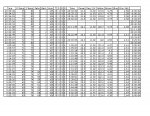I have a home logging system which has been running continuously since 2006, and the last modification was in 2010.
It has made nearly 6000 files to date. For details see http://projects.WorsleyAssociates.com/Environmental_Logger/
Well at 10:57:06 on Jan 24, 2014 it stopped recording.
I did not notice that the"SD" flag on the display was gone until mar 9, when I restarted it.
It has been functioning since, except that the exception code starting on line 464 on the attached code executes sporadically.
The test code at 190 always has an OK result.
No recording is lost.
I changed the Secure Digital memory to a freshly-formatted one and sprayed contact cleaner into its socket, but no change.
Can anyone tell me why/
It has made nearly 6000 files to date. For details see http://projects.WorsleyAssociates.com/Environmental_Logger/
Well at 10:57:06 on Jan 24, 2014 it stopped recording.
I did not notice that the"SD" flag on the display was gone until mar 9, when I restarted it.
It has been functioning since, except that the exception code starting on line 464 on the attached code executes sporadically.
The test code at 190 always has an OK result.
No recording is lost.
I changed the Secure Digital memory to a freshly-formatted one and sprayed contact cleaner into its socket, but no change.
Can anyone tell me why/
Attachments
-
27.5 KB Views: 17

